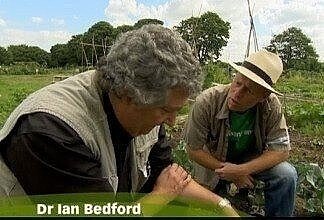
The role of imported produce in the spread of invasive pests
5 Minute Read
Dr Ian Bedford tells us everything we need to know about the 'bug of the month' for July, the box tree moth.Importing produce from all around the world nowadays has meant that exotic or out-of-season, flowers, plants, fruits, and vegetables are usually available in Britain’s markets throughout the year. Whilst imported plants and produce are regulated and inspected at their point of entry to Britain, there will always be a possibility that an invasive, non-native species could be transported in too.
Whether it be a plant, animal, or disease, the foreign invader could then pose a problem for Britain’s native species, crops, and maybe our homes and gardens too. Although this might appear to have become more frequent over recent years, it has been ongoing for hundreds of years. Nowadays, invasive species can be monitored and assessed for the impact that they might have on the environment and then managed, if possible, when required.
For many invasive species, the initial problems they cause will naturally become less severe over time, for reasons such as an inability to survive a severe winter, or perhaps being suppressed by native predators that discover it’s a suitable food source.
Some invasive species will have minimal impact on the environment they invade and can even become beneficial within their new environment. However, there is another type of invasive species that, when it first arrives, begins causing rapid and devastating harm to the environment, often to its detriment.
These are the invasive’s that are host-specific, the species that when their host has gone, lose their only food source and their ability to proliferate. One host-specific invasive species that Britain is currently experiencing, is a foreign moth, known as the Box tree moth (Cydalima perspectalis).

What is the Box Tree moth?
Originating from East Asia, the box tree moth was first discovered in Kent in 2007 on imported box trees and has since spread throughout Britain. Identified by its white delta-shaped wings with iridescent brown borders, box tree moths only lay their eggs on box (Buxus) plants, from which their green, black, and yellow striped larvae hatch.
Spinning a dense mat of webbing amongst the plant, the larvae then feed on the leaves defoliating and often killing smaller plants and bushes. Since first invading, it’s become clear that the box tree moth copes well with Britain’s climate and once a box tree has become infested, the larvae are effectively protected from predation and contact pesticides by the tough webbing they spin.
Whilst there’s some evidence that natural plant oils can deter adult moths from laying eggs, and that certain bacteria will kill their caterpillars, very little can be done to effectively eradicate an infestation once it’s become established and protected within webbing.
However, it’s very likely that in the near future, the box tree moth will be finding it increasingly harder to survive in Britain, since many of the plants, bushes, and hedges that it infects appear not to recover from the feeding damage and die. Consequently, gardeners are now replacing Buxus with alternative species for their hedges and topiary which are not host plants for the box tree caterpillars. Alternatives such as Taxus and Lonicera nitida will make it much harder for the box tree moths to find hosts for their eggs and larvae in the future.

About Dr Ian Bedford
Ian has been fascinated by the bug world for as long as he can remember. From studying butterflies on the South Downs as a youngster, he went on to pursue a career in Research Entomology and ran the Entomology Dept at the John Innes Centre in Norwich up until his recent retirement.VISIT WEBSITE

'Bug of the month'
Visit our 'bug of the month' archive.
Every month Ian will share his knowledge on how to protect your plants and gardens from preventable pest invasions while providing valuable insights into the insects regularly found in our gardens.
find out more
Comments (0)
Why not be the first to send us your thoughts?
Leave A Comment
Most popular articles
1
Plastic plant pots dimensions and uses2
Peat vs Peat Free - Choosing the right Potting Compost3
How to Grow Watercress at home in plant pots4
January Jobs5
Our guide to seed sowing compost